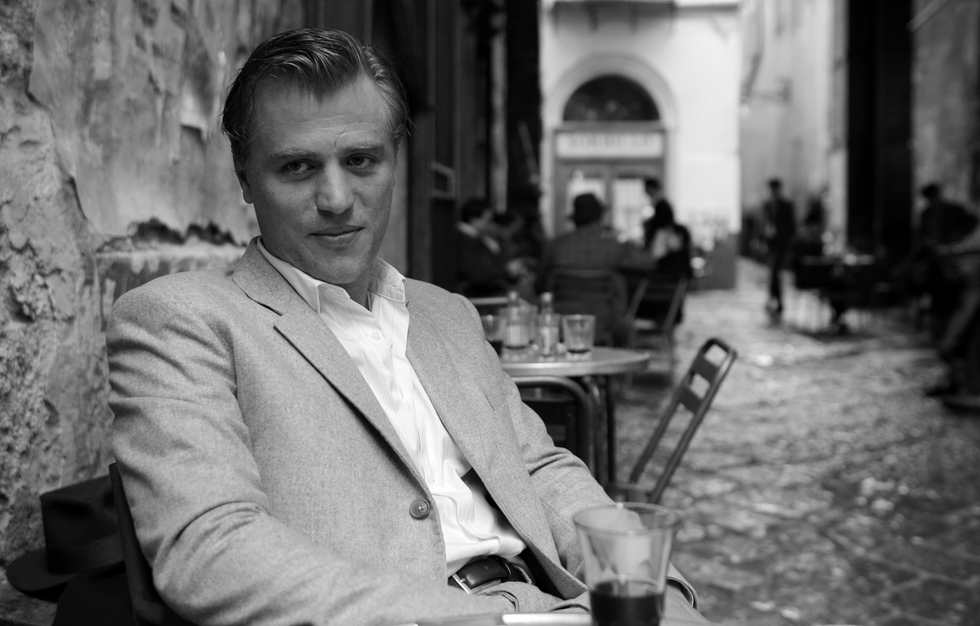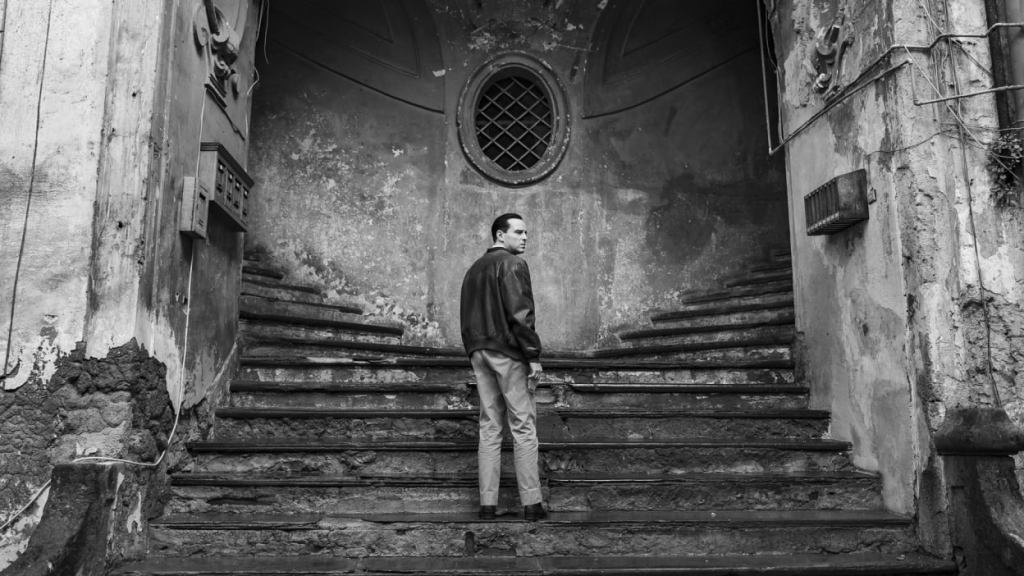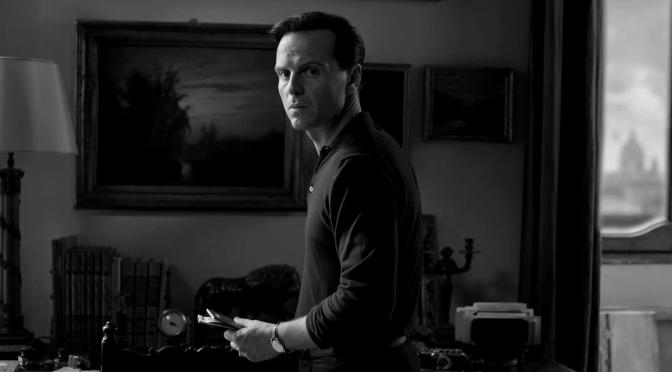
This is surely one of the most anticipated crime dramas of the year. Why? It’s based on a famous, iconic Patricia Highsmith novel from 1955 (she in her own right is pretty iconic and beloved), it’s been adapted by Steven Zaillian, screenwriter of Spileberg’s Schindler’s List and Scorsese’s The Irishman, and more recently for television, the brilliant The Night Of) and stars one of the hottest actors on the planet, Andrew Scott. That’s a lot of great pedigree.
Most people, when asked if they know the character Tom Ripley, will recall Anthony Minghella’s Oscar-nominated 1999 movie version, starring Matt Damon, Jude Law and Gwyneth Paltrow. Set in 1950s Italy, it was a summer dream of a film bursting with vibrant technicolour and la dolce vita.
This new, eight-part version… is, well, not. Read any review of Ripley, and it will undoubtedly start by discussing the look of the series. There is no colour here (actually there is, but only very fleetingly), the palette instead referencing classic noir films of the past and displaying stark, pristine black-and-white imagery.
It is exquisite.

Not just in its black and whiteness, but the way it is framed. Beautiful, artful cinematography, sublime mise en scène, of which the incredible mid-century Amalfi coast and Rome provide the churches, beaches, bare, faded and battered stone walls and maze-like streets. There is pleasing symmetry, stairs (oh, there are stairs), close-ups of gargoyles and statues, as well as art of the Old Masters (one in particular, more on him later).
Seriously, if you pause any scene in this series you would have in your possession screenshots worthy of hanging on the wall. The whole series has a still photographic quality about it, especially those like Paolo Di Paolo, William Klein or Bruno Barbey.
After saying all that, though, while what is on show here is indeed possibly the most impressive and gorgeous series you’ve ever seen in your life, the decision to actually shoot it in black and white is a curious one. After all, we see the ocean, lemon trees, cars (Fiat 500s galore), the art, the bright skies… places and objects that lend themselves to colour. Using black and white doesn’t quite make sense, especially when you consider that this is not a noir piece per se.
(Although there’s no arguing that the stark black and white palette adds to the drama, the time period, the intrigue and the chiaroscuro and tenebrism.)
But, for me, this is my favourite era so I’m not complaining at all about the colour scheme. Others will not be quite so onboard.
But now to the story.
When we meet Thomas Ripley (Scott) properly he is not so talented. Living in New York in a crumbling, one-bed apartment he’s a down-on-his-luck conman, practising identity theft and mail fraud. He’s not very good at it but is thrown a lifeline when a private detective mistakes him for a friend of his client’s son – Richard ‘Dickie’ Greenleaf. Dickie, it seems, is AWOL on the Amalfi coast, and his shipping magnate father wants him back in the US. To do this, he’s asking Tom Ripley to go out there, all expenses paid of course, and persuade Dickie to come home to his family.
Feeling that the feds are closing in on him in New York, Ripley can’t believe his luck and agrees to take on the challenge instantly.
There begins a whirl of a story, as Ripley arrives in Italy and acquaints himself with glorious Atrani and Dickie himself (Johnny Flynn) and his girlfriend Marge (Dakota Fanning). They’re living a life of bohemian luxury in a hilltop villa overlooking the Tyrrhenian Sea, swishing about all day in their linen shirts. Dickie is ‘working’ hard at trying to become a painter (his art is comically bad), and Marge wants to become a writer, holed up in her cottage looking for inspiration. They dine on the veranda or down in the town, speaking Italian.
Top Ripley is entranced.
Not merely a fascination, he’s obsessed with them and their lifestyle. And, developing his psychopathy that started in NYC with identity fraud, he begins to absorb Dickie and his lifestyle. He moves in with him, he’s caught trying on his clothes, he takes an interest in art… his wardrobe improves, and he begins to swindle money. Alarms bells ring for Marge and also with Dickie to some extent (who the hell is this guy?) but nothing is done about it until the natural conclusion to Ripley’s absorption happens and the real Dickie is no more. A dead Dickie.
In his place Ripley slides in and assumes Dickie life and identity.
The murder scene at sea (in episode three) is just fantastically staged. For 20 minutes, Ripley tries desperately to dispose of Dickie’s body, struggling and gasping for breath as their small boat bobs on the ocean. (There’s another murder in episode five, which is equally as tense.)

After the two murders, the talents of Mr Ripley begin to shine through – it seems he’s learned from his early days and is now one step ahead of everyone, including the brilliant Il Ispettore Ravini (a magnificently hangdog Maurizio Lombardi, who I would like to see a spin-off series of) and a returning Marge who on a few occasions seems to have found him out. But no, Ripley is one step ahead… scheming, plotting, working the two identities to his ultimate escape and leading them a merry dance through Italy, from Naples and Rome to Venice. (Although Dickie’s true identity is revealed to Ravini at the end.)
So what do we have here? An extraordinarily well-made series that is an intense and compelling study of sociopathy, and almost a real classic.
But there are a couple things that hold it back. Both Scott and Flynn are in their 40s (Scott approaching 50) and portraying characters in their, let’s say generously, 30s, which makes the idea of a father hiring a pal to bring his son home a little bit on the preposterous side. If Dickie Greenleaf and Tom Ripley were in their late teens or early 20s (like the 1999 movie) you could buy it, but their older age here? Nope, didn’t buy it one bit.
I also didn’t buy Dickie and Marge’s seeming ambivalence to Ripley himself. If I lived on the Amalfi coast and someone turned up out of the blue and tried so desperately to ingratiate themselves with me, I would be more than suspicious. I’d probably not invite them to live with me, and I’m pretty sure I would have turfed them out and contacted the police when I caught them trying on my clothes and impersonating me in front of a mirror.
There’s also a problem with Dickie himself. He’s lacking a bit in personality and charisma, which means the idea of Ripley becoming obsessed with him is a little far-fetched.
And one more thing… I’m not sure I bought the comparisons with Caravaggio. Our Tom is certainly a crook, a dangerous man and, yes, quite talented in his own sort of way, but unlike the 16th-century painter, he’s no super-genius. (There’s a very good explanation of Caravaggio and the links to the series here.)
What I did like? Scott is always watchable (although you have to admit, he’s a different and oddly charisma-less Ripley in this), and it really is the best-looking series you’ll see for a very long time. (I also liked the visual device of stairs throughout – sometimes it signified obstacles when climbing social strata, and sometimes literal obstacles when disposing of a body.)
(I also liked the fact that John Malkovich, who has also played Ripley in the past, popped up in this, too.)
All in all, Ripley is something to be luxuriated in, admired and perhaps even salivated over. But loved? I’m not quite so sure.
Paul Hirons

Yeah. Not quite sold. Scott a tad too old; neither he or the rest of the cast are engaging enough. If you want to see Ripley in all his, well, whatever, it’s John Malkovich, for the perfect ambivalence.
LikeLiked by 1 person
Bloody marvelous piece of great suspenseful film making . Best thing on the box for ages. Has a quality that so many productions lack.
LikeLike